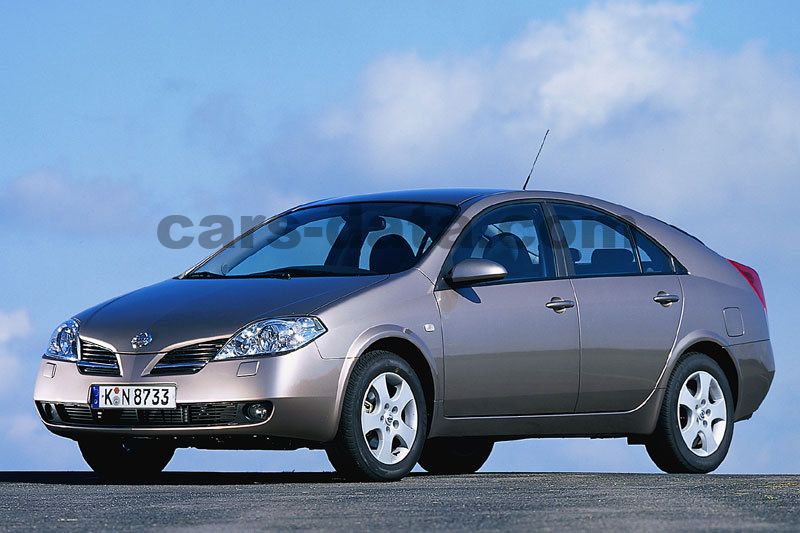
Nissan Primera 1.9 dCi Visia
An example is a very interesting car: still unusual in appearance, but, above all, recognizable from afar and no longer a “gray” Japanese.
Gray can also be understood literally, without quotes: the interior is far from the notorious barren average Japanese, bright but not gray, spacious, interesting, quite ergonomic and beautiful curves, where there are very readable gauges in the middle of the dashboard and a harmonious transition. dashboard to door trim.
The picture is not perfect: on the large (mostly color) central screen, little information is displayed at the same time, although there is enough space, there is a lot of noise inside (engine, turbocharger, wind at high speeds), but again not so much that it is especially annoying, a hole in the trunk obscenely small (4 doors!), and the steering wheel, which holds perfectly and looks neat, is not covered with leather.
Otherwise, this (for this engine) basic package already contains most of the equipment for which some competitors (well, at least part of it) have to pay extra: 6 airbags, active airbags, five three-point seat belts, ABS, radio. with CD, trip computer, both seats are adjustable in height, seat tilt and lumbar region, automatic air conditioning and electric power steering with central locking, all side windows and exterior mirrors.
With the new engine, Primera is undoubtedly more attractive. Common Rail Turbo Diesel has fast and intelligent preheating, and it runs very rough in the morning (shakes) and has since proven to be a very suitable machine for this wagon. Compared to the previous (turbodiesel) motorization, it is more decisive in all respects: when accelerating from standstill, but especially when it comes to flexibility and responsiveness at low revs.
At the same time, it is quite economical; If we can trust the on-board computer, it needs a speed of 130 km / h 5 and 150 6 liters of diesel fuel per 5 km and you need to drive 100 km / h to increase the consumption to 180 liters per 10 km. was within expectations - mostly moderate, only approaching ten hundred kilometers at a push.
Regardless of the environment it is in this time, the car behaves the same as in other cars where we find it: for a very fast ride, a speed of up to 3500 rpm is enough, but if you want to squeeze the maximum out of it ( for example, when driving) on a highway incline), it makes sense to only accelerate it to 4200 rpm, although the tachometer only has a red rectangle at 4800 rpm. But pumping it there is completely pointless (consumption!) And it is certainly economically unjustified in the long run.
Thus, such a motorized Primera will be a pleasure to drive. The steering wheel, pedals, and shifter feel a little stiff at first, but are almost unobtrusive. Slightly more inaccurate is the slightly inaccurate steering wheel, which can also be attributed to the "tall" tires, soft suspension and safe, secure road position - a good way to travel lightly.
It is not in capital letters that the engine is of French origin in this example, but anyone who knows a little about cars knows where the dCi label came from. The cooperation, this time Franco-Japanese, has borne (at least in this case) good results. This is probably why Nissan does not hide where the engine that you buy in this car comes from.
Vinko Kernc
Photo by Sasha Kapetanovich.
Nissan Primera 1.9 dCi Visia
Basic data
| Sales: | Renault Nissan Slovenia Ltd. |
|---|---|
| Base model price: | 22.266,73 € |
| Test model cost: | 22.684,03 € |
| Calculate the cost of auto insurance | |
| Power: | 88kW (120 KM) |
| Acceleration (0-100 km / h): | 10,8 with |
| Maximum speed: | 195 km / h |
| Mixed flow ECE: | 5,7l / 100km |
Technical information
| engine: | 4-cylinder - 4-stroke - in-line - direct injection diesel - displacement 1870 cm3 - maximum power 88 kW (120 hp) at 4000 rpm - maximum torque 270 Nm at 2000 rpm |
|---|---|
| Energy transfer: | front wheel drive - 6-speed manual transmission - tires 205/60 R 16 H (Dunlop SP Sport 300) |
| Capacity: | top speed 195 km / h - acceleration 0-100 km / h 10,8 s - fuel consumption (ECE) 7,3 / 4,8 / 5,7 l / 100 km |
| Mass: | empty vehicle 1480 kg - permissible total weight 1940 kg |
| External dimensions: | length 4567 mm - width 1760 mm - height 1482 mm - trunk 450-812 l - fuel tank 62 l |
Our measurements
| T = 14 ° C / p = 1030 mbar / rel. vl. = 48% / Odometer Condition: 2529 km | |
| Acceleration 0-100km: | 11,1s |
|---|---|
| 402m from the city: | 17,7 years ( 127 km / h) |
| 1000m from the city: | 32,2 years ( 164 km / h) |
| Flexibility 50-90km / h: | 8,8 / 14,4s |
| Flexibility 80-120km / h: | 11,7 / 16,7s |
| Maximum speed: | 198km / h (WE.) |
| test consumption: | 7,7 l / 100km |
| Braking distance at 100 km / h: | 40,8m |
| AM table: | 40m |
We praise and reproach
engine flexibility and responsiveness
gear ratios
rich equipment package
bright and neat interior
recognizable exterior
poor physical and sound insulation of the engine
display data on the center screen
trunk access
